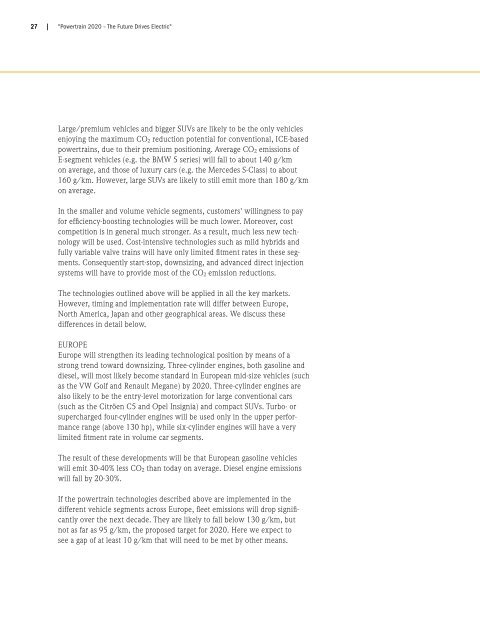Powertrain 2020 - The Future Drives Electric (PDF ... - Roland Berger
Powertrain 2020 - The Future Drives Electric (PDF ... - Roland Berger
Powertrain 2020 - The Future Drives Electric (PDF ... - Roland Berger
Create successful ePaper yourself
Turn your PDF publications into a flip-book with our unique Google optimized e-Paper software.
27 |<br />
"<strong>Powertrain</strong> <strong>2020</strong> – <strong>The</strong> <strong>Future</strong> <strong>Drives</strong> <strong>Electric</strong>"<br />
Large/premium vehicles and bigger SUVs are likely to be the only vehicles<br />
enjoying the maximum CO 2 reduction potential for conventional, ICE-based<br />
powertrains, due to their premium positioning. Average CO 2 emissions of<br />
E-segment vehicles (e.g. the BMW 5 series) will fall to about 140 g/km<br />
on average, and those of luxury cars (e.g. the Mercedes S-Class) to about<br />
160 g/km. However, large SUVs are likely to still emit more than 180 g/km<br />
on average.<br />
In the smaller and volume vehicle segments, customers' willingness to pay<br />
for efficiency-boosting technologies will be much lower. Moreover, cost<br />
competition is in general much stronger. As a result, much less new technology<br />
will be used. Cost-intensive technologies such as mild hybrids and<br />
fully variable valve trains will have only limited fitment rates in these segments.<br />
Consequently start-stop, downsizing, and advanced direct injection<br />
systems will have to provide most of the CO 2 emission reductions.<br />
<strong>The</strong> technologies outlined above will be applied in all the key markets.<br />
However, timing and implementation rate will differ between Europe,<br />
North America, Japan and other geographical areas. We discuss these<br />
differences in detail below.<br />
EUROPE<br />
Europe will strengthen its leading technological position by means of a<br />
strong trend toward downsizing. Three-cylinder engines, both gasoline and<br />
diesel, will most likely become standard in European mid-size vehicles (such<br />
as the VW Golf and Renault Megane) by <strong>2020</strong>. Three-cylinder engines are<br />
also likely to be the entry-level motorization for large conventional cars<br />
(such as the Citröen C5 and Opel Insignia) and compact SUVs. Turbo- or<br />
supercharged four-cylinder engines will be used only in the upper performance<br />
range (above 130 hp), while six-cylinder engines will have a very<br />
limited fitment rate in volume car segments.<br />
<strong>The</strong> result of these developments will be that European gasoline vehicles<br />
will emit 30-40% less CO 2 than today on average. Diesel engine emissions<br />
will fall by 20-30%.<br />
If the powertrain technologies described above are implemented in the<br />
different vehicle segments across Europe, fleet emissions will drop significantly<br />
over the next decade. <strong>The</strong>y are likely to fall below 130 g/km, but<br />
not as far as 95 g/km, the proposed target for <strong>2020</strong>. Here we expect to<br />
see a gap of at least 10 g/km that will need to be met by other means.

















